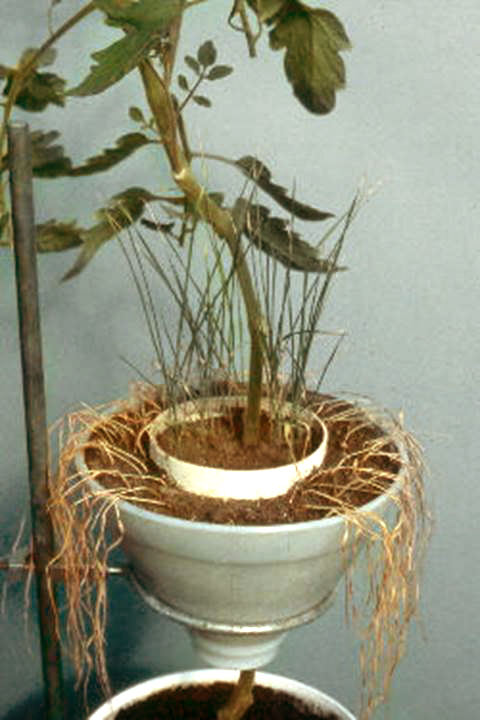
Plants Share Water?!

On a sunny, dry day in late summer, Amy stood in a water parched field with white indigo plants. As she toiled for many mindless hours picking the indigo seed, she began to notice that the grass around an indigo plant was greener and bigger than the grasses farther from the indigo plant. “What is going on?” she wondered.
Dr. Dale Blevins noticed the same thing as he was observing orchard grass plants growing near alfalfa plants. So, he began to study this phenomenon and discovered that it was originally described in 1929 when a man named Breazeale grew a tomato and wheat together. The tomato plant was rooted in two separate pots while the wheat only had access to the top pot. Some wheat plants could touch the tomato’s roots while others were kept separate with a plastic divider. A drought was imposed on the top pot that the tomatoes and wheat were growing in while the bottom pot that only the tomato accessed continued to receive water. The wheat plants touching the tomato survived the drought whereas those separated from the tomato died. The tomato must be “sharing water” with the wheat! This process has been termed hydraulic lift.
“But, why would a plant share water with neighboring plants?” scientists have wondered. It is thought that the deep-rooted plant transports this water at night when it has need for very little water so it “stores” the water in the soil near the soil surface to be used the following day when water needs are high. In the mean-time, the shallow-rooted plants take advantage of the situation and use some of this stored water. It is also hypothesized that when the deep-rooted plant releases moisture into the soil, the nutrients in that soil are more available to all the plants. Additionally the soil life (e.g. mycorrhizal fungi and other microorganisms), which is so important in recycling nutrients and sometimes even acquiring the nutrients for the plants, has adequate moisture to keep functioning meaning that the plant’s nutrient availability and uptake could be better.1
Intrigued by the concept of “sharing”, Dr. Blevins and his comrades devised an experiment with deeply-rooted alfalfa and shallow-rooted corn. A 100 day drought was imposed upon the corn while water was given freely to the alfalfa. Sure enough, the water given to the alfalfa was found in the very top leaves of the corn plant! Although the corn did not thrive, it survived 100 days of drought. 2 Then they wondered if nutrients would be “shared” as well. Sure enough, potassium and phosphorus that were given to the alfalfa were “transferred” to the corn.3
This concept of “stealing” water from another plant goes against our sense of right and wrong. However, in a grassland our objective is often not to raise the biggest and best specimen of a certain species of plant. Rather, we aim to produce as much forage as possible. If the water and nutrients brought up by hydraulic lift are shared with other plants, more forage can be produced. This is especially true when the species that does the lifting is not palatable, such as is the case with the indigos that Amy was picking the seed from. We are more concerned about the whole than the individual. Hydraulic lift seems to not only be good for the lifters but also the shallow-rooted neighbors; this is good for the whole. Things that are good for the whole are good for us as people because we are part of the whole.
1 A review of the research and current thoughts on hydraulic lift entitled “Hydraulic lift: a potentially important ecosystem process” by J.L. Horton and S.C. Hart can be found in the 1998 journal, Trends in Ecology and Evolution, volume 13 pages 232-235.
2 A report on the experimental procedures and findings of S.J. Corak, D.G. Blevins and S.G. Pallarrdy can be found in the article, “Water Transfer in an Alfalfa/Maize Association: Survival of maize during drought” which was published in 1987 in Plant Physiology volume 84 pages 582-586.
3 The work with potassium transfer was published in an article, “Transfer of Rb-86 (potassium) from deeply rooted alfalfa (Medicago sativa L.) to associated shallow rooted maize (Zea mays L.) or grain sorghum (Sorghum vulgare Pers.)” by J.E. Habben and D.G. Blevins in the 1989 edition of the Journal of Plant Nutrition volume 12 pages 1089-1104. The work with phosphorus was obtained by personal communication with Dale Blevins.


